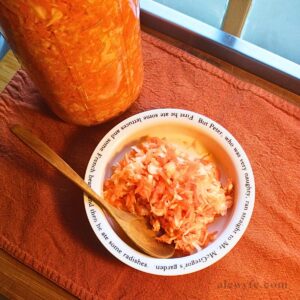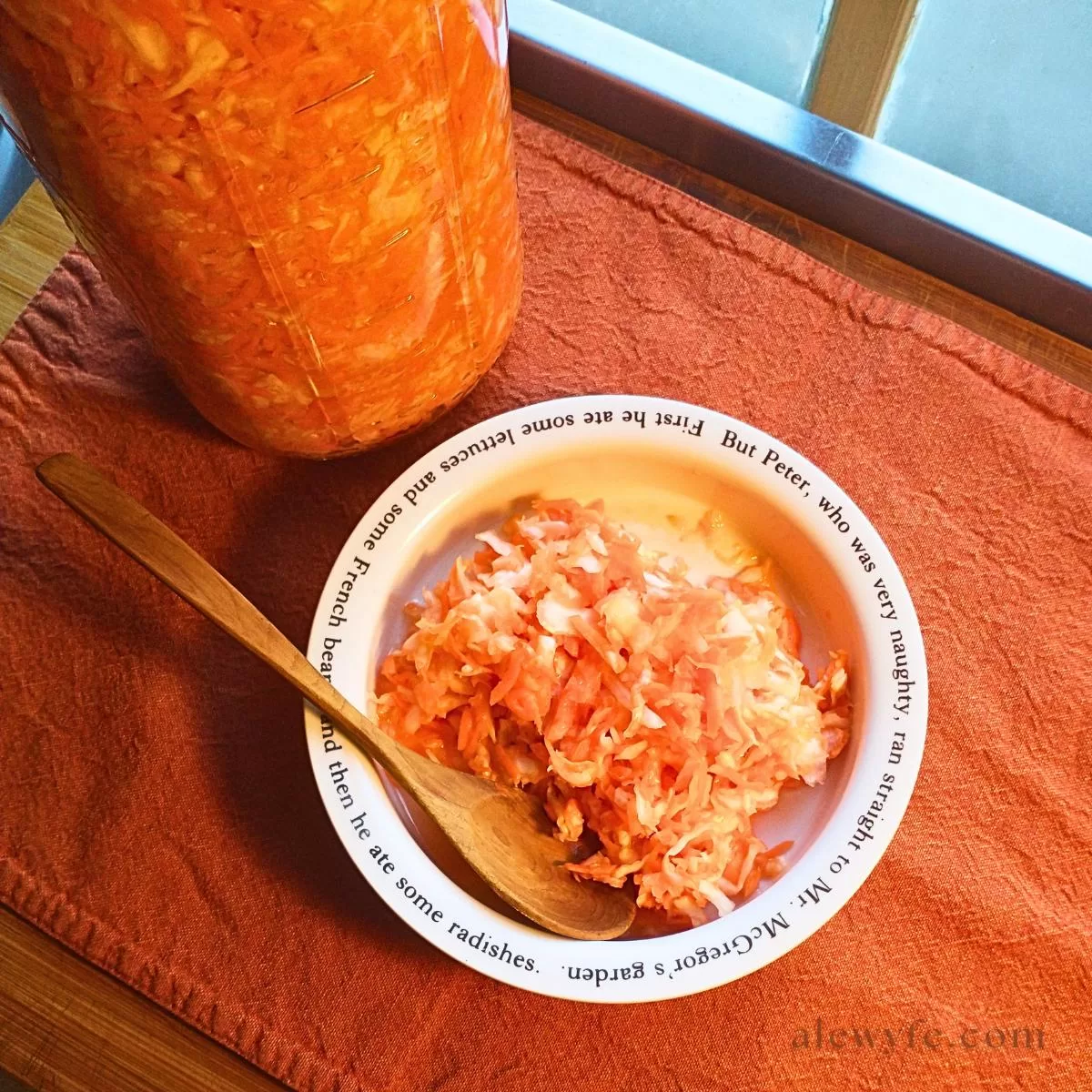LACTO-FERMENT: Zesty Ginger Carrot-Cabbage Slaw (an unconventional kraut)
- Serving Ideas for Ginger Carrot-Cabbage Slaw
- Lacto-fermented Carrot-Cabbage Slaw Ingredients
- Equipment & Method for Homemade Kraut
- Storing your Fermented Carrot-Cabbage Slaw
This naturally lactofermented carrot-cabbage slaw isn’t your typical kraut. It’s flavored with spicy fresh ginger, and has a pleasant tang and bright flavor that isn’t overwhelming. You can serve this after a few days, while it’s very crunchy with just a hint of acidity, or let it go longer and develop a more assertive kick.
Serving Ideas for Ginger Carrot-Cabbage Slaw
It’s nice as a simple, nutritious side salad to serve with steamed dumplings, pot-stickers, or bao buns. Pair it with grilled meats and kebabs, especially when they’re basted with richly flavored plum sauce or spicy peach BBQ sauce. Keep it simple with some crispy tofu and rice, or a bowl of rice and soft-boiled eggs. I like to add a big scoop to a bowl of ramen, or on top of a plate of cold sesame noodles.
It’s good on sandwiches… try some of this gingered carrot-cabbage slaw on top of a bánh mì with crispy pork belly, a grilled eggplant focaccia sandwich with a soy sauce marinade, or roll some up in a veggie wrap with marinated tofu or white-bean hummus. Add it to spring rolls with rice noodles, or use it for homemade eggroll or wonton filling, either with sauteed veggies and mushrooms, ground pork, or a blend.
You can serve this plain, especially when it’s fresh and not as sharp. Or, dress it simply with toasted sesame oil and maybe some smoked almonds to add depth. You can stir in a spoonful of mayo or yogurt, dried currants or raisins, and diced apple or Asian pear for a creamy, crunchy sweet summer slaw with an extra kick. If it gets too tart to enjoy as a salad, mix it with some freshly shredded cabbage or carrots before serving to tone it down, or toss it with some spring greens just before serving.
Lacto-fermented Carrot-Cabbage Slaw Ingredients
Cabbage:
Savoy or regular cabbage works here. I use green cabbage to let the bright orange color of the carrots shine, but you could use red cabbage for a vibrantly colored kraut. Don’t use bagged pre-shredded slaw, as it usually has preservatives that will keep it from fermenting properly.
Carrots:
Washed, peeled, and grated fresh carrots. Use regular orange carrots, or rainbow carrots for even more color.
Salt:
You can use kosher salt, canning and pickling salt, or sea salt here. Avoid iodized salt for best flavor. For consistently reliable results, you need a scale. Use two to three percent salt by weight of the total vegetables. Use more salt in hot weather and less if you have a cool place to ferment your slaw.
Weigh your total vegetables (after peeling)… if you aren’t using metric units, convert to ounces (multiply lbs x 16), and multiply the total ounces by 0.02 or 0.03 to determine your salt, by weight.
For example: 5 lbs total vegetables x 16 oz = 80 oz x 0.02 = 1.6 oz salt (round to 2 oz).
You can wing it with a few tablespoons per layer and tasting the final product to make sure it’s salty enough to ferment without spoiling (or TOO salty to ferment properly or taste good). Until you are familiar with the process it’s best to weigh your ingredients and take out any guesswork! Plus different types of salt have very different volume measurements. A tablespoon of kosher salt weighs a lot less than a tablespoon of fine sea salt, but an ounce is an ounce! You can find conversion charts online but get a scale if you can.
Ginger, chili, or other optional seasonings:
You can leave your carrot-cabbage slaw plain, or spice it up! This recipe has grated or minced ginger, which adds a warm and spicy flavor. For a moderately gingered batch, use a tablespoon of ginger paste, or add up to three tablespoons for a really strong and spicy ginger flavor.
You could also add a small amount of garlic, chili flakes or minced fresh chili peppers, pink peppercorns, mustard seeds, or coriander… just not all of the above! Stick with one or two compatible flavor add-ins until you are familiar with the process, then mix it up and get as wild as you like! A good ratio is one or two teaspoons of additional dry flavorings per quart, or up to a few tablespoons per half-gallon batch.
Equipment & Method for Homemade Kraut
If you haven’t made sauerkraut before and aren’t already familiar with the equipment and techniques, check out our introductory post about making homemade sauerkraut to learn more about the best and easiest ways to make sure your batch of lacto-fermented carrot slaw is a success!
While you can buy beautiful dedicated fermentation crocks if you get into making these as a hobby, you can get started with just some basic supplies. You might already have everything you need in your kitchen!
Sharp knife & cutting board, box grater, slaw board/mandoline, or food processor with grater & shredder plates:
You can slice the cabbage by hand with a sharp knife, and grate the carrots & ginger, but a food processor makes this take minutes instead of what feels like forever.
Kraut tamper, wooden french rolling pin, wooden dowel or spoon:
You want to pound and pack the salted vegetable mixture into your fermentation containers. This lightly bruises the veggies and helps them release juice to make the brine, and also gets rid of any trapped air. If you’re using glass jars, be careful to do this gently so you don’t crack your jars (ask me how I know).
Pickle weights, plastic bag filled with brine, or a plate that fits in your crock under the lid:
Optional… you can make a successful fermented slaw without covering the surface, especially if you’re using an airlock on your ferment, but these help keep the fermenting veggies submerged in the brine. It can also help prevent the formation of kahm yeast, a white harmless growth, but that can make your slaw soggy and gross. If this happens, scrape that layer off and compost it. The slaw underneath should be fine. If you get blue or black mold though, discard the batch. Keeping the mixture under the salt-brine will help keep your ferment safe and tasty.
Airlocks, “Pickle Pipes”, or Plastic jar lids:
You want to let out the gasses from fermentation, but keep out bugs and contaminants. There are various ways to do this, but you can also use a loosely fitting lid. If you want the best success rate though, use an airlock. People also use vacuum sealers and bags for their ferments, so if you have one, you could try that. I prefer keeping my ferments in glass.

Storing your Fermented Carrot-Cabbage Slaw
Like most live fermented foods, you should keep this cool and store it in a dark place. A fridge is ideal, but you can also keep it in a cool closet or pantry, cabinet, basement, or root cellar.
Check your ferments periodically, and remove any yeast that forms on the top (a white layer that isn’t mold). Discard any that grow black or green mold, as the spores & filaments may have spoiled the whole jar. This shouldn’t happen if you keep your ferments covered, under brine, and always use clean utensils to serve them!
You can store this lacto-fermented ginger carrot slaw for months as long as it is kept somewhere cool and dark. The flavor will continue to develop, and it will become sharper and tangier the longer it is stored. Keeping it in the fridge will slow this down though, so once you get the perfect flavor, try to make room in the fridge for your finished slaw… or just eat it and start your next batch so it’s ready when the first one is gone!

FERMENT: Zesty Ginger Carrot-Cabbage Kraut
Ingredients
- 3 lbs shredded cabbage
- 2 lbs grated carrots
- 1 tbsp ginger (use 2-3 tbsp for very spicy slaw)
- 2 oz salt
Instructions
- Wash and peel your carrots. Trim the outer leaves from the cabbage (if necessary). Quarter the cabbage and cut diagonally to remove the tough core.
- Weigh your cabbage & carrots, and calculate the salt if the weights are different than those above (keep the same basic ratio of veggies until you're familiar with fermenting).
- Peel and grate or puree the fresh ginger.
- Thinly slice or shred your cabbage and carrots.
- Mix everything together in a large mixing bowl, layering the salt and ginger as you add the vegetables to the bowl so it's easier to get a uniform mix. Toss them well. It's easiest to mix them with clean hands, but you can also use tongs.
- Let the mixture sit for 5-10 minutes. The salt will begin to pull liquid from the vegetables to make a brine.
- Carefully pack the shredded veggies into wide mouth glass jars, crocks, or fermenting containers. Tamp them down as you add the layers to press out the air.
- Divide the liquid left in the bowl between the jars. Let sit a few more minutes and top up with cold water if needed to bring the brine level above the slaw. Add glass or ceramic weights if you are using them.
- Cover the jars with airlocks, lids fitted loosely enough to allow gasses to escape, or with tightly woven cloth tied on or rubber-banded to the top.
- Place in a moderately cool place (ideally between 55-70 ℉) for 5-14 days. The slaw will ferment faster in warmer temperatures, but will retain more crunch and a cleaner flavor with a longer, cooler ferment.
- Sample periodically with a clean utensil, and refrigerate your slaw when it has reached the level of tang you like. You can also continue to store it in a cool, dark place like a cellar or cold pantry. The flavor will continue to develop and will eventually be quite sharp (if you don't eat it all first!).
